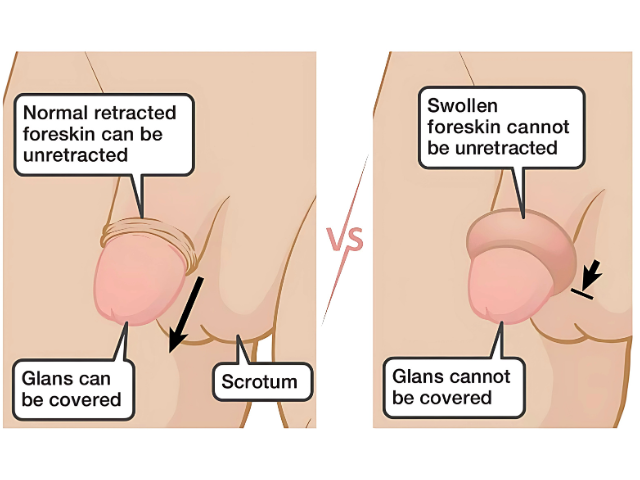Paraphimosis requires immediate medical intervention. If left untreated, it can cause irreversible damage to the penis. Read on to learn about this condition, its causes, symptoms, and treatment options at KK Virat Hospital, Karimnagar.
What Is Paraphimosis?
Paraphimosis is a severe medical condition in which the foreskin becomes trapped behind the head of the penis and does not return to its normal position. This condition restricts blood flow to the penis, potentially leading to permanent damage. It primarily affects uncircumcised or partially circumcised males and requires urgent medical care.

How Does Paraphimosis Occur?
Paraphimosis can occur due to multiple reasons, including:
Underlying medical conditions such as diabetes
- Keeping the foreskin retracted for extended periods after cleaning, urinating, or sexual activity
- Improper handling of the foreskin during a physical examination
- Penile injuries
- Post-circumcision complications
- Infections
Paraphimosis Diagnosis
Paraphimosis is typically diagnosed through a physical examination. The doctor will assess the penis and ask about symptoms to determine the severity of the condition. No additional tests are usually required.
When to Consult a Doctor for Paraphimosis Treatment?
Seek medical attention immediately if you experience:
- Difficulty urinating
- Severe pain and discomfort
- Inability to pull the foreskin back over the penis head
- Swelling and redness of the penis
- Tenderness and restricted blood flow
Complications if Paraphimosis is Left Untreated
If untreated, paraphimosis can lead to serious complications such as:
- Gangrene (tissue death), potentially leading to partial or complete penile loss
- Severe infections
- Tissue damage in the penis
Preventing Paraphimosis
To reduce the risk of paraphimosis:
- Consider circumcision if recurrent issues occur
- Always return the foreskin to its normal position after cleaning, urinating, or sexual activity
- Maintain proper penile hygiene
- Avoid leaving the foreskin retracted for long periods
Paraphimosis Treatment Procedure
Surgical Treatment
For severe or recurrent cases, circumcision is the most effective treatment. The following circumcision techniques are available at KK Virat Hospital:
1. Open Circumcision Surgery:
- Traditional method involving local or general anesthesia
- Foreskin is measured, retracted, and removed using a scalpel
- The incision is closed with dissolvable stitches
2. Laser Circumcision Surgery:
- Minimally invasive technique using a high-precision laser
- No stitches required, with minimal bleeding and faster recovery
- Performed under local or general anesthesia
- Same-day discharge with minimal discomfort
3. Stapler Circumcision Surgery:
- Fast healing with minimal postoperative complications
- Uses a surgical stapler for a precise and quick procedure
- Minimal pain and no visible scars
Post-Surgery Care & Recovery
Proper postoperative care is crucial for a smooth recovery:
- Refrain from sexual activity for at least four weeks
- Take prescribed pain medications as directed by your doctor
- Wear loose-fitting clothing and supportive underwear to minimize discomfort
- Avoid heavy activities for a few weeks post-surgery
- Keep the incision area clean and dry; avoid using soaps or gels directly on the wound
Risks of Surgery
While circumcision is generally safe, potential complications include:
- Allergic reactions to anesthesia (nausea, vomiting, headache)
- Infection at the incision site
- Excessive bleeding
- Improper foreskin removal (too much or too little skin removed)
- Wound healing issues or scarring
Insurance Coverage for Paraphimosis Treatment
Paraphimosis requiring circumcision is classified as a medical emergency and is covered by most insurance policies. KK Virat Hospital provides full insurance assistance to help patients navigate the claim process seamlessly. Contact our insurance team for detailed information regarding your coverage.
Why Choose KK Virat Hospital for Paraphimosis Treatment?
- Experienced Urologists – Our team consists of top urologists specializing in treating Paraphimosis conditions.
- Advanced Surgical Techniques – We use the latest methods like laser and stapler circumcision for safe and effective treatment.
- Personalized Treatment Plans – We offer tailored treatment based on individual patient needs.
- Affordable & Insurance-Covered Treatments – We ensure cost-effective solutions with insurance assistance.
Book Your Appointment Today
For expert diagnosis and advanced treatment of paraphimosis, visit KK Virat Hospital, Karimnagar. Book an appointment today!
- Call Us Directly: Get in touch with our medical coordinators to schedule an appointment with an expert urologist.
- Direct Visit: You can visit our hospital directly by carrying your previous medical records if you have a medical history. However, admission will be based on the doctor’s recommendation.
How can I manually reduce paraphimosis?
You can try to reduce paraphimosis by gently compressing the swollen foreskin and glans with your fingers to reduce swelling, then carefully pulling the foreskin back over the glans. Applying a cold compress or a lubricant may help. However, this should only be attempted under medical guidance.
Does paraphimosis go away on its own?
No, paraphimosis does not go away on its own. If left untreated, it can lead to severe complications like restricted blood flow, tissue damage, and even gangrene. Immediate medical intervention is necessary.
Is paraphimosis an emergency?
Yes, paraphimosis is a urological emergency. It requires urgent treatment to restore blood circulation and prevent permanent damage to the penis. If you suspect paraphimosis, seek medical help immediately.
What is the difference between paraphimosis and phimosis?
Phimosis is when the foreskin cannot be retracted over the glans, while paraphimosis occurs when the foreskin is pulled back and gets stuck, causing swelling and restricting blood flow. Paraphimosis is a medical emergency, whereas phimosis can often be managed with conservative treatments.
What are the symptoms of paraphimosis?
Symptoms of paraphimosis include swelling of the glans, severe pain, tightness or constriction of the foreskin, difficulty urinating, and bluish or dark discoloration of the glans due to restricted blood flow.
What causes paraphimosis?
Common causes of paraphimosis include improper retraction of the foreskin during cleaning or catheterization, penile trauma, infections, poor hygiene, and conditions like diabetes that affect circulation.
How is paraphimosis treated?
Paraphimosis treatment involves manual reduction, ice packs to reduce swelling, medications to relieve pain and inflammation, and, in severe cases, circumcision or surgical release of the constricted foreskin.
Can paraphimosis be prevented?
Yes, paraphimosis can be prevented by maintaining good hygiene, always repositioning the foreskin after cleaning or urination, and avoiding forceful retraction. In recurrent cases, circumcision may be recommended.
How long does recovery take after paraphimosis treatment?
Recovery time depends on the treatment method. If treated with manual reduction, recovery is immediate. However, if surgery is needed, healing can take 2-4 weeks, with proper aftercare and hygiene practices.
Is surgery necessary for paraphimosis?
Surgery is not always necessary. In mild cases, manual reduction can resolve the issue. However, in severe or recurrent cases, circumcision or a dorsal slit procedure may be required to prevent future occurrences.


